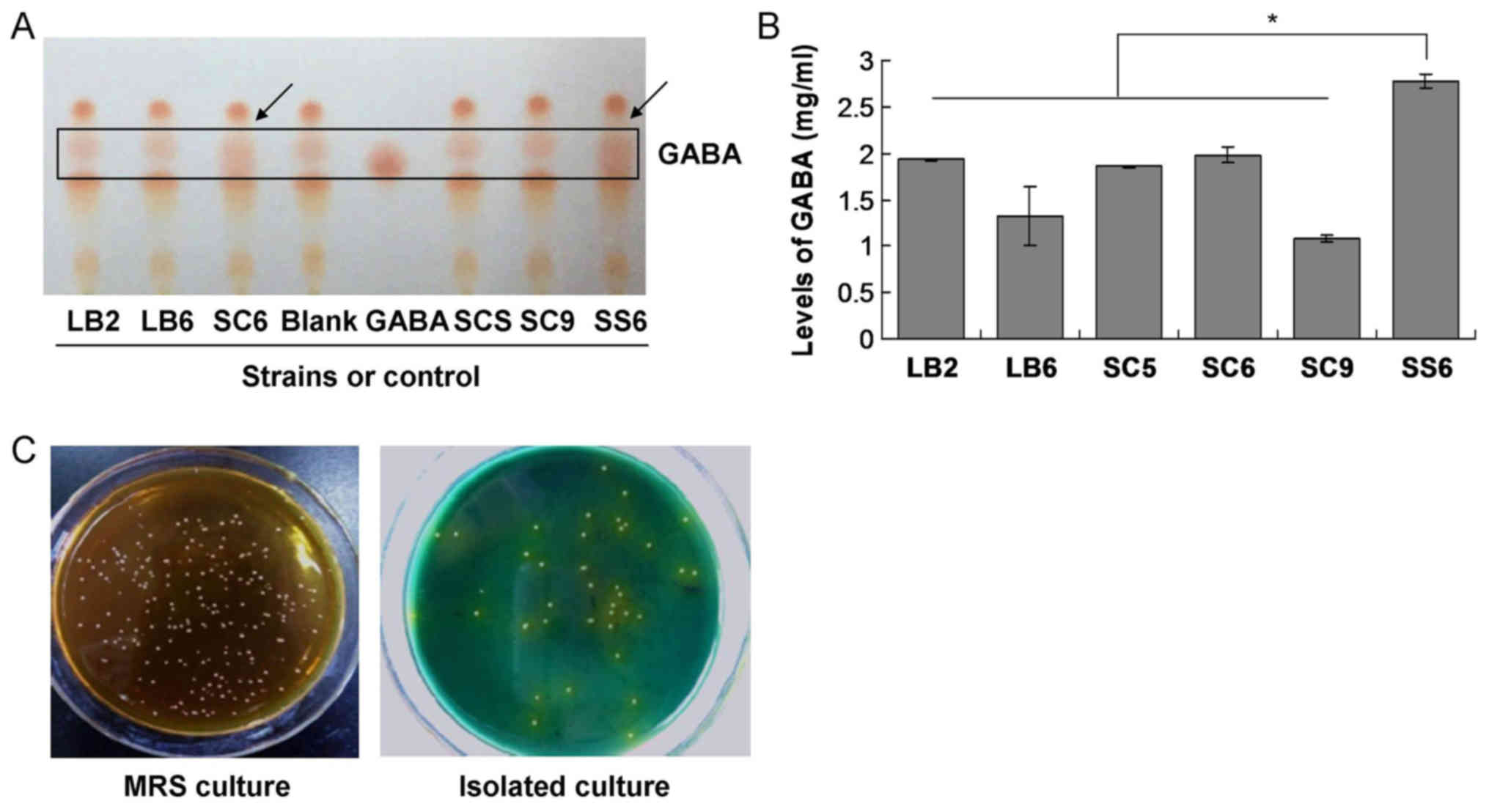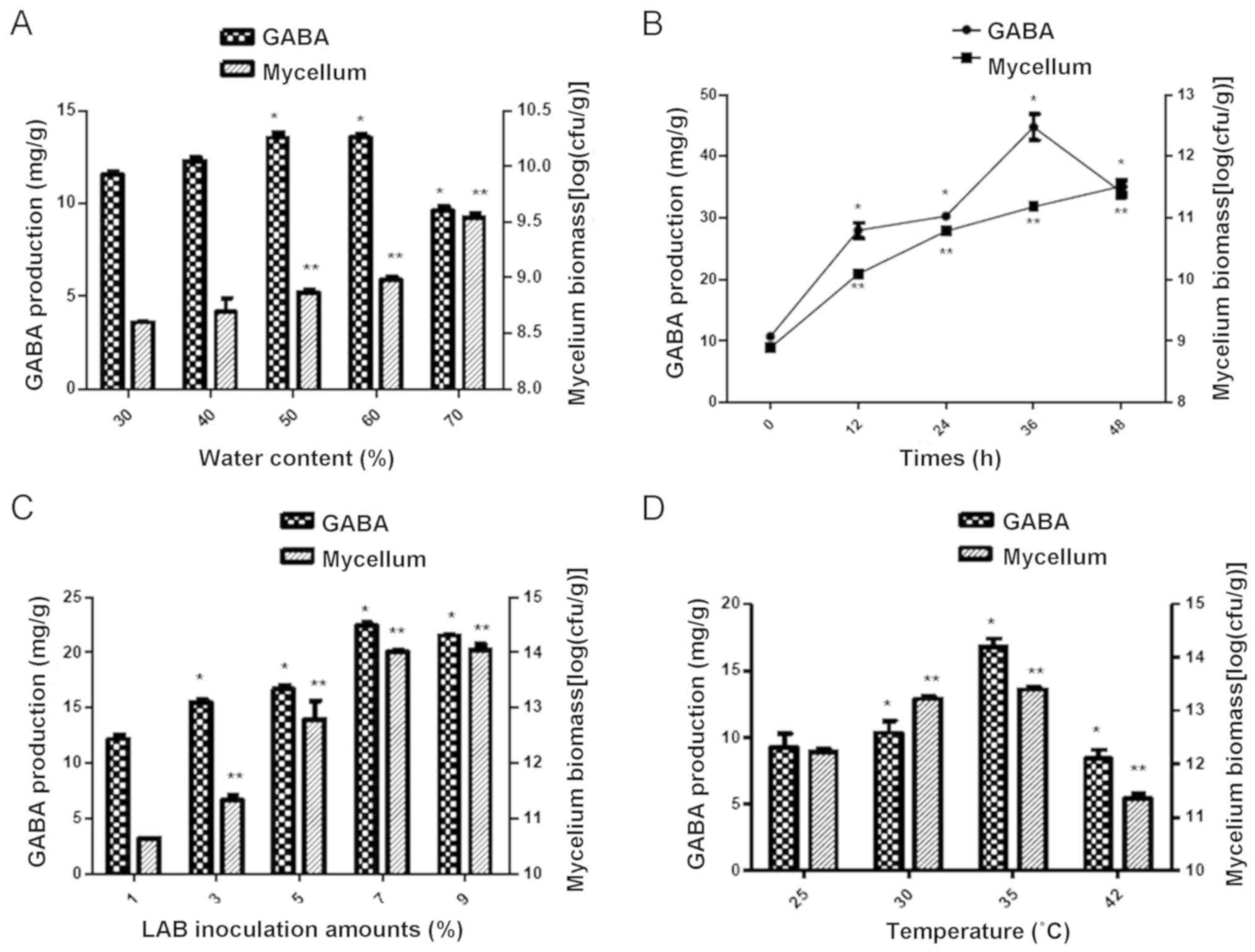|
1
|
Yu T, Jiang Z, Liu L and Fan Z: Decrease
of gamma-aminobutyric acid and zinc ions in the islet periportal
circulation stimulates glucagon secretion during hypoglycemia. Exp
Ther Med. 15:2507–2511. 2018.PubMed/NCBI
|
|
2
|
Kondoh T, Mallick HN and Torii K:
Activation of the gut-brain axis by dietary glutamate and
physiologic significance in energy homeostasis. Am J Clin Nutr. 90
(Suppl):832S–837S. 2009. View Article : Google Scholar : PubMed/NCBI
|
|
3
|
Wong CG, Bottiglieri T and Snead OC III:
GABA, gamma-hydroxybutyric acid, and neurological disease. Ann
Neurol. 54 (Suppl 6):S3–S12. 2003. View Article : Google Scholar : PubMed/NCBI
|
|
4
|
Miura D, Ito Y, Mizukuchi A, Kise M, Aoto
H and Yagasaki K: Hypocholesterolemic action of pre-germinated
brown rice in hepatoma-bearing rats. Life Sci. 79:259–264. 2006.
View Article : Google Scholar : PubMed/NCBI
|
|
5
|
Park KB and Oh SH: Production of yogurt
with enhanced levels of gamma-aminobutyric acid and valuable
nutrients using lactic acid bacteria and germinated soybean
extract. Bioresour Technol. 98:1675–1679. 2007. View Article : Google Scholar : PubMed/NCBI
|
|
6
|
Kim JY, Lee MY, Ji GE, Lee YS and Hwang
KT: Production of gamma-aminobutyric acid in black raspberry juice
during fermentation by Lactobacillus brevis GABA100. Int J
Food Microbiol. 130:12–16. 2009. View Article : Google Scholar : PubMed/NCBI
|
|
7
|
Chuang CY, Shi YC, You HP, Lo YH and Pan
TM: Antidepressant effect of GABA-rich monascus-fermented product
on forced swimming rat model. J Agric Food Chem. 59:3027–3034.
2011. View Article : Google Scholar : PubMed/NCBI
|
|
8
|
Barthelmebs L, Calas-Blanchard C,
Istamboulie G, Marty JL and Noguer T: Biosensors as analytical
tools in food fermentation industry. Adv Exp Med Biol. 698:293–307.
2010. View Article : Google Scholar : PubMed/NCBI
|
|
9
|
Lucke FK: Utilization of microbes to
process and preserve meat. Meat Sci. 56:105–115. 2000. View Article : Google Scholar : PubMed/NCBI
|
|
10
|
Wang D, Dong Z, Zhang Y, Guo K, Guo P,
Zhao P and Xia Q: Proteomics provides insight into the interaction
between mulberry and silkworm. J Proteome Res. 16:2472–2480. 2017.
View Article : Google Scholar : PubMed/NCBI
|
|
11
|
Gryn-Rynko A, Bazylak G and
Olszewska-Slonina D: New potential phytotherapeutics obtained from
white mulberry (Morus alba L.) leaves. Biomed Pharmacother.
84:628–636. 2016. View Article : Google Scholar : PubMed/NCBI
|
|
12
|
Chen H, He X, Liu Y, Li J, He Q, Zhang C,
Wei B, Zhang Y and Wang J: Extraction, purification and
anti-fatigue activity of gamma-aminobutyric acid from mulberry
(Morus alba L.) leaves. Sci Rep. 6:189332016. View Article : Google Scholar : PubMed/NCBI
|
|
13
|
Süle J, Kõrösi T, Hucker A and Varga L:
Evaluation of culture media for selective enumeration of
bifidobacteria and lactic acid bacteria. Braz J Microbiol.
45:1023–1030. 2014. View Article : Google Scholar : PubMed/NCBI
|
|
14
|
Zhao Z, Wei L, Li CY, Wang Z, Hu YW, Liu
CC and Ma F: Study on optimization of proportion between fermented
liquid and traditional cultural medium of bioflocculant production
and its flocculant performance considering the aerobic fermentation
of rice straw as substrate. Pak J Pharm Sci 27 (6 Suppl).
S2119–S2123. 2014.
|
|
15
|
Lee HJ, Lee H, Choi YI and Lee JJ: Effect
of lactic acid bacteria-fermented mulberry leaf extract on the
improvement of intestinal function in rats. Korean J Food Sci Anim
Resour. 37:561–570. 2017. View Article : Google Scholar : PubMed/NCBI
|
|
16
|
Tongpim S, Meidong R, Poudel P, Yoshino S,
Okugawa Y, Tashiro Y, Taniguchi M and Sakai K: Isolation of
thermophilic L-lactic acid producing bacteria showing
homo-fermentative manner under high aeration condition. J Biosci
Bioeng. 117:318–324. 2014. View Article : Google Scholar : PubMed/NCBI
|
|
17
|
Wu Q and Shah NP: Gas release-based
prescreening combined with reversed-phase HPLC quantitation for
efficient selection of high-gamma-aminobutyric acid
(GABA)-producing lactic acid bacteria. J Dairy Sci. 98:790–797.
2015. View Article : Google Scholar : PubMed/NCBI
|
|
18
|
Tajabadi N, Ebrahimpour A, Baradaran A,
Rahim RA, Mahyudin NA, Manap MY, Bakar FA and Saari N: Optimization
of gamma-aminobutyric acid production by Lactobacillus
plantarum Taj-Apis362 from honeybees. Molecules. 20:6654–6669.
2015. View Article : Google Scholar : PubMed/NCBI
|
|
19
|
Marino A, Bellinghieri V, Nostro A, Miceli
N, Tariano MF, Guvenc A and Bisignano G: In vitro effect of branch
extracts of Juniperus species from Turkey on staphylococcus aureus
biofilm. FEMS Immunol Med Microbiol. 59:470–476. 2010. View Article : Google Scholar : PubMed/NCBI
|
|
20
|
Barrett E, Ross RP, Fitzgerald GF and
Stanton C: Rapid screening method for analyzing the conjugated
linoleic acid production capabilities of bacterial cultures. Appl
Environ Microbiol. 73:2333–2337. 2007. View Article : Google Scholar : PubMed/NCBI
|
|
21
|
Crittenden RG, Martinez NR and Playne MJ:
Synthesis and utilisation of folate by yoghurt starter cultures and
probiotic bacteria. Int J Food Microbiol. 80:217–222. 2003.
View Article : Google Scholar : PubMed/NCBI
|
|
22
|
Rosberg-Cody E, Stanton C, O'Mahony L,
Wall R, Shanahan F, Quigley EM, Fitzgerald GF and Ross RP:
Recombinant lactobacilli expressing linoleic acid isomerase can
modulate the fatty acid composition of host adipose tissue in mice.
Microbiology. 157:609–615. 2011. View Article : Google Scholar : PubMed/NCBI
|
|
23
|
Sreekumar O and Hosono A: The
antimutagenic properties of a polysaccharide produced by
Bifidobacterium longum and its cultured milk against some
heterocyclic amines. Can J Microbiol. 44:1029–1036. 1998.
View Article : Google Scholar : PubMed/NCBI
|
|
24
|
Barrett E, Ross RP, O'Toole PW, Fitzgerald
GF and Stanton C: γ-Aminobutyric acid production by culturable
bacteria from the human intestine. J Appl Microbiol. 113:411–417.
2012. View Article : Google Scholar : PubMed/NCBI
|
|
25
|
Cryan JF and O'Mahony SM: The
microbiome-gut-brain axis: From bowel to behavior.
Neurogastroenterol Motil. 23:187–192. 2011. View Article : Google Scholar : PubMed/NCBI
|
|
26
|
McKay DM and Bienenstock J: The
interaction between mast cells and nerves in the gastrointestinal
tract. Immunol Today. 15:533–538. 1994. View Article : Google Scholar : PubMed/NCBI
|
|
27
|
Zhao A, Hu X, Pan L and Wang X: Isolation
and characterization of a gamma-aminobutyric acid producing strain
Lactobacillus buchneri WPZ001 that could efficiently utilize
xylose and corncob hydrolysate. Appl Microbiol Biotechnol.
99:3191–3200. 2015. View Article : Google Scholar : PubMed/NCBI
|
|
28
|
Brasca M, Hogenboom JA, Morandi S, Rosi V,
D'Incecco P, Silvetti T and Pellegrino L: Proteolytic activity and
production of γ-aminobutyric acid by streptococcus thermophilus
cultivated in microfiltered pasteurized milk. J Agric Food Chem.
64:8604–8614. 2016. View Article : Google Scholar : PubMed/NCBI
|
|
29
|
Tong JC, Mackay IR, Chin J, Law RH, Fayad
K and Rowley MJ: Enzymatic characterization of a recombinant
isoform hybrid of glutamic acid decarboxylase (rGAD67/65) expressed
in yeast. J Biotechnol. 97:183–190. 2002. View Article : Google Scholar : PubMed/NCBI
|
|
30
|
Binh TT, Ju WT, Jung WJ and Park RD:
Optimization of gamma-amino butyric acid production in a newly
isolated Lactobacillus brevis. Biotechnol Lett. 36:93–98.
2014. View Article : Google Scholar : PubMed/NCBI
|














